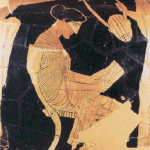So you’ve already signed A Pagan Community Statement on the Environment, and you don’t want Earth Day (April 22) to go by unobserved. What can you do? Over the next 21 days, I will be offering practical and productive suggestions for how you can honor the Earth this Earth Day.
Ecologist Dolores LaChapelle says that ritual is essential to creating intimate, conscious relationship with the places where we dwell. It is no coincidence that native societies tend both to be ecologically sustainable and to have a rich ceremonial life. “We have tried to relate to the world around us through only the left side of our brain, and we are clearly failing. We need to rediscover the wisdom of these other cultures who know that their relationship to the land and to the natural world required the whole of their being.” LaChapelle explains that rituals “connect the conscious with the unconscious, the right and left hemispheres of the brain, the cortex with the older three brains … as well as connecting the human with the non-human — the earth, the sky, the animals and plants.”
But not all rituals succeed in doing this … not even all Pagan rituals. The relationship of contemporary Paganism with the natural world is not an uncomplicated one. Neo-Pagans have inherited ritual forms and theology from British Traditional Wicca, which did not itself begin as a nature religion, but as an esoteric mystery cult. The resulting ritual and symbolic forms sometimes bear an ambiguous relationship to nature.
The celebration of the Wheel of the Year, perhaps the most common contemporary Neo-Pagan ritual, is often explained as an expression of our desire to connect with nature. Yet consider how many Pagans, living in myriads climatic zones, follow a universalist Wheel of the Year derived from the climate of Great Britain, which may or may not correspond with the local environmental conditions. As Dr. Jo Pearson has observed, the Pagan Wheel of the Year sometimes turns the seasons, rather than the other way around.
Similarly, when we invoke the “elements,” often in indoor, air-conditioned settings, these may take the form of abstract Neo-Platonic essences, rather than the actual earth beneath our feet and the air and water flowing around us. And as centerpiece of such a ritual, we might undertake an imaginal “journey” to a grove or other sacred natural site to converse with spirits or deities — without ever interacting with wild nature.* Then we may top it off with cakes and ale served in styrofoam cups.
One thing you can do to honor the Earth this Earth Day is to help reground our Pagan rituals. Let’s begin by asking the hard questions: Do our rituals help us experience the natural world or do they actually cut us off from it? Do our circles connect us to others or cut us off from the rest of the world? Are we, as Steve Posch says, standing with our backs to the world, both literally and figuratively? Is our Paganism too inwardly-focused? Is our connection to the “elements” just in our heads? Is our magic just another attempt to achieve mastery over the natural world? Are we consumeristic even in our rituals? Do we only look at nature for what it can give us, like harvest foods and hidden spiritual meanings? And when we do give back, are the offerings we are leaving in nature actually healthy for plants and animals that live there?
Let’s work to “green our magics” and to craft rituals that really connect us to the more than human.
* Note: Of course, not all Pagans are physically or financially able to get to wild spaces, but many more of us can than do. And for those of us who can’t, perhaps a backyard might be preferable to a living room, even (or especially) in inclement weather.

















